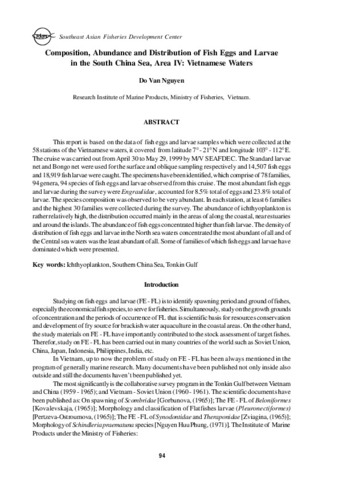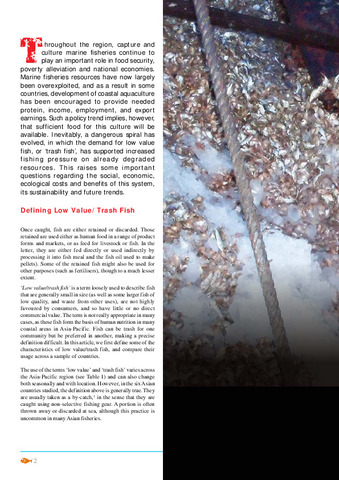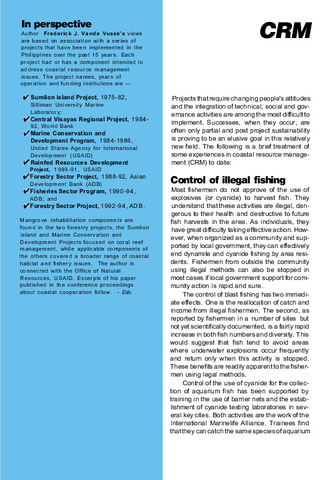Composition, abundance and distribution of fish eggs and larvae in the South China Sea, Area IV : Vietnamese waters
Share
抄録
This report is based on the data of fish eggs and larvae samples which were collected at the 58 stations of the Vietnamese waters, it covered from latitude 7° - 21° N and longitude 103° - 112° E. The cruise was carried out from April 30 to May 29, 1999 by M/V SEAFDEC. The Standard larvae net and Bongo net were used for the surface and oblique sampling respectively and 14,507 fish eggs and 18,919 fish larvae were caught. The specimens have been identified, which comprise of 78 families, 94 genera, 94 species of fish eggs and larvae observed from this cruise. The most abundant fish eggs and larvae during the survey were Engraulidae, accounted for 8.5% total of eggs and 23.8% total of larvae. The species composition was observed to be very abundant. In each station, at least 6 families and the highest 30 families were collected during the survey. The abundance of ichthyoplankton is rather relatively high, the distribution occurred mainly in the areas of along the coastal, near estuaries and around the islands. The abundance of fish eggs concentrated higher than fish larvae. The density of distribution of fish eggs and larvae in the North sea waters concentrated the most abundant of all and of the Central sea waters was the least abundant of all. Some of families of which fish eggs and larvae have dominated which were presented.
Suggested Citation
Nguyen, D. V. (2001). Composition, abundance and distribution of fish eggs and larvae in the South China Sea, Area IV?: Vietnamese waters. In Proceedings of the Fourth Technical Seminar on Marine Fishery Resources Survey in the South China Sea, Area IV: Vietnamese Waters, 18-20 September 2000 (pp. 94-145). Bangkok, Thailand: Secretariat, Southeast Asian Fisheries Development Center.
主題
Related items
Showing items related by title, author, creator and subject.
-
'No' to cyanide fishing!
Dagoon, N. J. (Aquaculture Department, Southeast Asian Fisheries Development Center, 1999) -
Prized commodity: Low value/trash fish from marine fisheries in the Asia-pacific region
Staples, Derek; Funge-Smith, Simon (Secretariat, Southeast Asian Fisheries Development Center, 2005)The use of the terms 'low value' and 'trash fish' varies across the Asia-Pacific region and can also change both seasonally and with location. This article defines low value/trash fish as 'Fish that have a low commercial ... -
CRM in the Philippines: Lessons learned
Southeast Asian Fisheries Development Center, Aquaculture Department (Aquaculture Department, Southeast Asian Fisheries Development Center, 1996)Philippine coastal communities can become capable fishery resource managers and that their management practices can become largely self-sustaining if the project approach focuses on assisting fishermen to learn how to help ...





